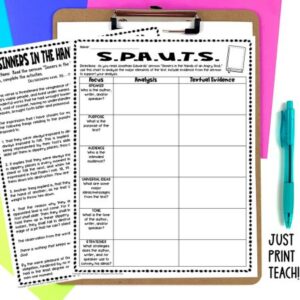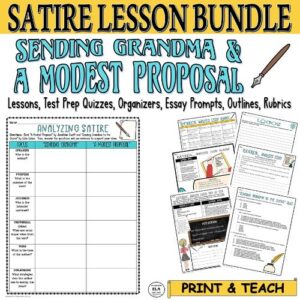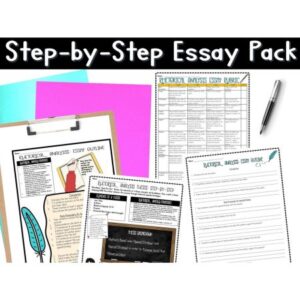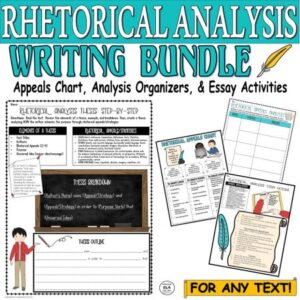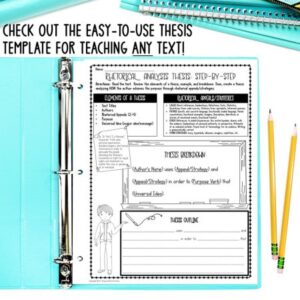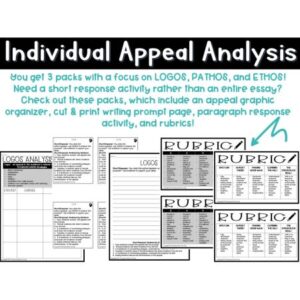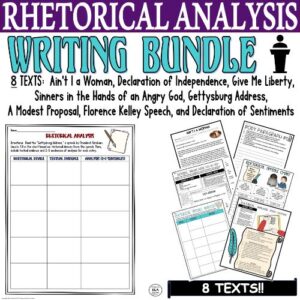When students hear “Rhetorical Analysis” for the very first time, they usually have NO idea what these words mean. And don’t even try introducing an Outline for Rhetorical Analysis Essay Writing until you review the meaning of this phrase…
Heck, we as teachers may not really encounter these words in the classroom unless we are preparing students to take the exam for AP English Language and Composition or for future college composition classes. Too often, we are so consumed with teaching basic reading comprehension, writing the five-paragraph essay, and helping students take the end-of-the-year standardized test.
So higher-level analysis of important passages finds its way to the backseat of our teaching. I would argue, however, that if we can get our students reading, analyzing, and responding to rhetoric, test prep becomes a piece of cake! To aid our students in this endeavor, we need to provide as much help as possible. Over the last 17 years of teaching, I have realized ONE immutable fact; students NEED a step-by-step process that they can use for EVERY piece of rhetoric. This is when bringing in an Outline for Rhetorical Analysis Essay Writing helps!
Keep reading to learn about 5 Effective Elements of an Outline for Rhetorical Analysis Essay Writing for High School Students!
Need help with Test Prep? Check out this FREE Pack of 3 Test Prep Activities to help students achieve success on standardized tests!
5 Elements of an Effective Outline for Rhetorical Analysis Essay Writing
1. The thesis template includes the rhetorical situation.
I personally like the S.P.A.U.T.S. method to help students prepare to write the thesis of the outline for rhetorical analysis essay writing; it is kind of like S.O.A.P.S.T.O.N.E., but it is MADE for informational texts!
S-Speaker: Who is the writer or speaker?
P-Purpose: What is the purpose of the text?
A-Audience: Who is the intended audience?
U-Universal Ideas: What are some major ideas from the text?
T-Tone: What is the tone of the author?
S-Strategies: What strategies does the author use to convey ideas?
Before you have your students read and use an outline for rhetorical analysis essay assignments, introduce this acronym to help them focus on what they need to be successful for the rhetorical analysis essay.
Check out the activity below for “Sinners in the Hands of an Angry God!”
THESIS STATEMENT TEMPLATES
Outlines for 2 strategies-
- In _____________________ (title or description of the text), _________________ (author’s full name or last name) uses ________________ (strategy/appeal/device) and _________________ (strategy/appeal/device) in order to argue that _____________________________________ (purpose & universal idea).
- In _____________________ (title or description of the text), _________________ (author’s full name or last name) uses ________________ (strategy/appeal/device), ________________ (strategy/appeal/device), and _________________ (strategy/appeal/device) in order to argue that _____________________________________(purpose & universal idea).
Outlines for 3 strategies-
- _________________________ (author’s name) in ____________________ (title or description of the text) works to convince _____________________ (audience) that ______________________(purpose & universal idea) by incorporating _________________ (strategy/appeal/device) and _________________ (strategy/appeal/device).
- _________________________ (author’s name) in ____________________ (title or description of the text) works to convince _____________________ (audience) that ______________________(purpose & universal idea) by incorporating _________________ (strategy/appeal/device), _________________ (strategy/appeal/device), and _________________ (strategy/appeal/device).
SAMPLE THESIS STATEMENT:
Ex. In “A Modest Proposal,” Jonathan Swift uses factual information, emotional language, and credible sources in order to criticize the English authorities, so they will bring about change in the treatment of the Irish people.
Check out the Satire Bundle below for help with teaching an outline for rhetorical analysis essay assignments in response to Satire!
Want an EASY way to teach satire? Click below for help!
MY FAVORITE TEXTS TO TEACH RHETORICAL ANALYSIS:
- A Modest Proposal
- Ain’t I a Woman
- Sinners in the Hands of an Angry God
- Sending Grandma to the Ovens
- The Declaration of Independence
- Gettysburg Address
- Declaration of Sentiments
- Give Me Liberty or Give Me Death
- Child Labor Speech
2. The introduction is short, specific, and effective!
After teaching rhetorical analysis to high school and college students for many years, I can tell you that students get so overwhelmed by the introduction that they don’t spend enough time on the body paragraphs. There is a BIG difference between writing a piece of rhetoric versus writing a rhetorical analysis. And when students hyper-focus on how to start the introduction, they get frustrated before the really hard work begins in the body paragraphs.
Instead, let’s make it easy for our students.
- The Hook- We don’t need students to write a traditional hook with a question, quotation, or (God-forbid) an anecdote. Instead, encourage students to simply introduce the topic and its importance.
- The Bridge- In 2-3 sentences, simply have students provide the context: what is going on in the time period of the passage, the author, the title if there is one, and some basic info from the passage.
- The Thesis- Students should include the title, author, purpose, universal idea (message), audience, and strategies used.
Really, 4-5 sentences are enough…
3. Each body paragraph of the Outline for Rhetorical Analysis Essay Writing has a focus.
After reading countless rhetorical analysis papers, I can say that there is no one RIGHT way to structure a body paragraph.
- Beginner-Level Rhetorical Analysis Writers-Focus on a strategy for each paragraph. ØLOGOS: Direct references, Explanations, Definitions, Facts, Statistics, Quotations from valid sources, Citations from specialists, Informed opinions ØPATHOS: Specific and concrete language, Emotionally loaded language, Varied connotations, Emotional examples, Imagery, Description, Narratives or stories of emotional events, Emotional tone(s), Figurative Language ØETHOS: References to beliefs/experiences the writer/speaker shares with the audience, Explanations of personal authority or perspective, Attempts at an unbiased outlook, Proper level of terminology for an audience, Writing is grammatically correct
- Mid-Level Rhetorical Analysis Writers– Students can always still focus on a strategy; however, you could offer students an additional option for structure. Perhaps, you could have students focus on similar ideas for each paragraph and/or multiple devices. So instead of using just facts or metaphors for each paragraph, students could write about the use of figurative language or facts and statistics! When having students write about similar ideas, you could have students discuss the multiple purposes of the author with a focus on varied devices for the purpose within each paragraph.
- Higher-Level Rhetorical Analysis Writers-One of the coolest techniques I have seen is when students focus on the structure of the rhetoric from beginning to end. Each paragraph discusses a different part of the text. Students will still analyze the devices; however, when students see how the devices and the structure contribute to effective rhetoric, they usually have the opportunity to score higher on the AP Lang Exam.
CLICK BELOW FOR A RHETORICAL ANALYSIS WRITING PACK YOU CAN USE WITH ANY TEXT!
4. The body paragraphs follow a similar structure.
When we have done research on anything, we need to put the ideas into some sort of order. In comes an outline for rhetorical analysis essay or paragraph writing! A step-by-step or even sentence-by-sentence paragraph within the outline for rhetorical analysis essay assignments can be so helpful!
Body Paragraphs: By Device/Strategy/Appeal
- Topic sentence-connect the strategy with the purpose
- Textual evidence-cite direct evidence from the text
- 2-4 sentences of commentary/analysis; how does the evidence support the purpose?
- Transition to another piece of textual evidence-cite direct evidence from the text
- 2-4 sentences of commentary/analysis; how does the evidence support the purpose?
- Ending sentence-discuss the effectiveness of the strategy
PRO TIP—>Offer students the use of an analysis verbs list to help with broadening their commentary. It is FREE in my store!
You could also start out with a simpler outline for rhetorical analysis essay paragraph options to allow for student differentiation in length:
- 1 body paragraph
- 2 body paragraphs
- 3 body paragraphs
- 4 body paragraphs
Ultimately, you know your students. Think about what each needs and start where each student or group of students is!
CLICK BELOW FOR A RHETORICAL ANALYSIS OUTLINE YOU CAN USE WITH ANY TEXT!
5. The conclusion is relevant and says something new.
The usual go-to of the conclusion is to start with restating the thesis; let’s help our students avoid this!
Instead, follow this 3-step conclusion within the Outline for Rhetorical Analysis Essay Writing!
- Discuss the ultimate purpose of the text
- What makes the author effective? How?
- End on an idea that connects to a greater, more universal concept/belief as to why the text itself is important
So often, students will write their outline, and then the essay looks totally different from what they initially outlined. Many times, students don’t realize that they can use all of the resources they have put time into to actually write their essays.
After they use the outline, you might even want to help them refine their ideas, structure, or overall writing a little.
CLICK BELOW FOR AN OUTLINE FOR RHETORICAL ANALYSIS ESSAY WRITING GUIDE YOU CAN USE WITH ANY TEXT!
Some Things to Consider When Providing an Outline for Rhetorical Analysis Essay Writing
More than anything, we want to guide our students in thinking about what someone is doing when he/she writes something…anything. You might not want to start out with satire. You could use an ad or simple narrative instead.
Meet your students where they are when beginning the journey of teaching rhetorical analysis!
Want a writing bundle that you can use for ANY rhetorical analysis that includes an Outline for Rhetorical Analysis Essay Writing? CLICK BELOW!
Need more fun lessons and activities connected to an Outline for Rhetorical Analysis Essay Writing? Check out my store Kristin Menke-Integrated ELA Test Prep!


